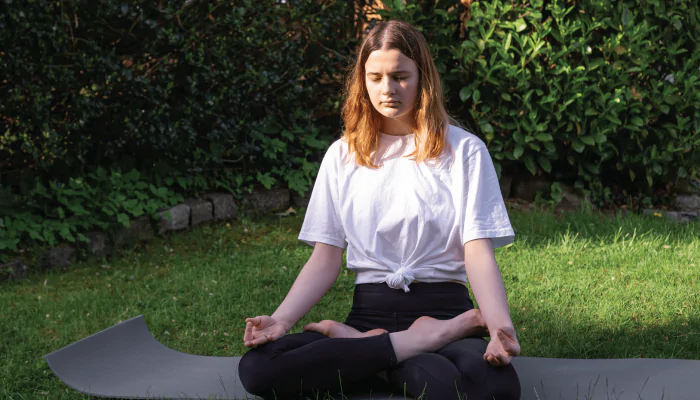“In every walk with nature, one receives far more than he seeks.” — John Muir
You’ve tried meditating at home, following guided audios or breathing exercises. But no matter how hard you try to focus, something feels off. You’re distracted. You’re restless. Or you simply don’t feel the peace everyone else keeps talking about.
If that sounds like you, there’s a simple solution you might be overlooking:
Take your meditation outside:
Nature isn’t just a beautiful backdrop — it’s a powerful partner in healing your mind, body, and emotional state. This article isn’t just about telling you that meditating outdoors feels good — it’s about why it works, how it solves specific problems, and how to make it part of your regular practice.
Common Problems People Face During Meditation Indoors:

Before we dive into nature-based solutions, let’s look at what’s going wrong indoors:
- Too many distractions (phones, noise, roommates, or clutter)
- Overthinking and mental restlessness
- Lack of motivation or boredom with the practice
- Struggling to stay present or keep the mind from wandering
- Feeling disconnected from the experience
Sound familiar? Nature addresses all of these.
Natural Settings Help You Focus Without Forcing It
The Problem: Indoors, you often try to focus too hard — and it backfires. You end up chasing stillness instead of experiencing it. The Nature Solution: Nature gently pulls your attention into the present. The sway of trees, ripple of water, or chirping birds require zero effort to notice — and yet they keep your awareness grounded.

Psychologists call this “soft fascination” — it restores your attention span without overwhelming your brain. Tip: Instead of fighting distractions, let the sounds of nature become your meditation anchor.
Nature Instantly Lowers Stress and Anxiety
The Problem: Meditation is meant to calm your mind, but ironically, it can trigger frustration or anxiety when you can’t “do it right.”
The Nature Solution: Multiple studies have shown that even 5–20 minutes in natural environments:
- Reduces cortisol (stress hormone)
- Decreases heart rate and blood pressure
- Improves emotional regulation
The result? A more relaxed mind — the perfect state for meditation to work. Tip: Start your practice with a short walk in a park. Let your senses open before you sit down to meditate.
Sensory Overload Indoors vs. Sensory Balance Outdoors
The Problem: Indoors, you’re often in a visually dull or overly stimulating environment (screens, bright lights, artificial sounds). The Nature Solution: Nature engages all five senses in a soothing, non-intrusive way:

- Sight: Trees, clouds, flowing water
- Sound: Birds, wind, distant animals
- Smell: Fresh grass, earth, flowers
- Touch: Cool breeze, ground beneath you
- Breath: Naturally becomes deeper and slower
This multi-sensory input grounds your awareness and brings you fully into the “now.” Tip: Try a “Five Senses Meditation” outdoors — pause to name 1 thing you see, hear, smell, feel, and taste.
Feeling Disconnected? Meditation in Nature Restores That Sense of Belonging
The Problem: A significant reason meditation doesn’t feel “deep” is because we feel emotionally or spiritually disconnected — from ourselves, from others, from life.
The Nature Solution: Being in nature restores a sense of connection to something greater. It naturally dissolves ego-centred thinking and invites a deeper experience of oneness. Nature doesn’t demand anything of you. It simply welcomes you. Tip: Meditate under a tree, near water, or on a trail where you feel small — not insignificant, but part of something vast and wise.
It Boosts Consistency and Motivation
The Problem: You’re not motivated to meditate because it feels repetitive, forced, or inconvenient indoors.
The Nature Solution: Outdoor meditation feels more like an experience than a chore. The freshness, beauty, and unpredictability of nature renew your curiosity. You’re more likely to:

- Look forward to it
- Meditate for longer
- Return more often
Tip: Make it a morning or sunset ritual. Connect it to something enjoyable — like tea in the garden or a walk to a scenic spot.
How to Get Started with Nature Meditation (Even If You Live in a City)
You don’t need a remote forest. Here’s how to practice in different settings:
Minimal Nature Access:
- A balcony with plants
- Sitting near a window with a view
- Local city parks or green spaces
Medium Nature Access:
- Gardens, botanical parks
- Riverside or lakeside areas
- Forest edges or nature trails
Full Nature Immersion:
- Forest bathing (Shinrin-yoku)
- Mountain hikes
- Beach meditations
- Camping retreats
What to Do
- Choose a calm place. Sit, stand, or lie down comfortably.
- Focus on your breath or the soundscape around you.
- If your mind wanders, gently return to a natural anchor (birdsong, tree movement, breath).
- Start with just 5–10 minutes, then build up.
Bonus: Science That Backs It All
- The University of Michigan found that walking in nature boosts memory and attention by 20%.
- Stanford researchers showed that nature walks reduce rumination (repetitive negative thinking).
- Japanese Forest Bathing studies reveal that spending time among trees boosts immunity and reduces depression.
Final Thoughts: Let Nature Guide You Back to Yourself

Meditation doesn’t have to be a struggle. If you’ve been feeling disconnected, restless, or discouraged with your practice, it’s not your fault — you just need a new environment. Nature offers a path that’s been waiting for you since the beginning of time. So next time your mind is noisy or your heart feels heavy, step outside. Let the sky hold your thoughts, let the earth ground your worries, and let nature do what it does best — heal you.
Action Step:
This week, try meditation in nature at least once. Start with a walk, then sit somewhere quiet. Observe how you feel before and after. Let us know how it goes in the comments — and don’t forget to share this with someone who needs a fresh start with meditation.

